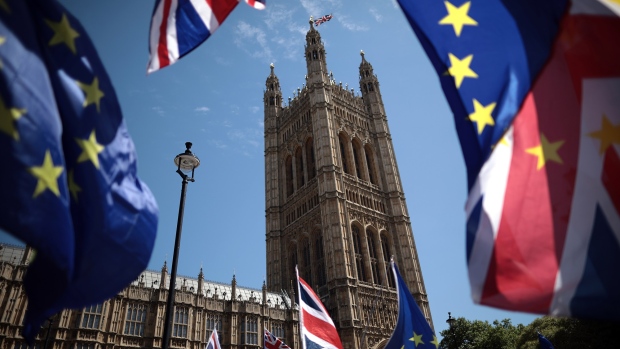Mar 12, 2019
U.K. weighs no-deal Brexit vote as May is plunged into crisis
, Bloomberg News

Britain will confront head-on the threat of a no-deal Brexit in a parliamentary vote with huge ramifications for Prime Minister Theresa May.
On Wednesday, lawmakers will decide whether to tear the country out of the European Union with no agreement in place in 16 days’ time, or give themselves the chance to delay Brexit in the hope of securing better terms.
If -- as expected -- Parliament rejects leaving without an accord on March 29, there will be another vote Thursday on whether to ask the EU for more time and delay departure day. An extension, which markets would welcome, could however provoke furious pro-Brexit officials to quit May’s administration, and even set in train a chain of events that could bring her government down.
The stakes could hardly higher -- and the future looks uncertain -- after May failed for a second time to get Parliament to sign off on a divorce deal that was the culmination of two years of tortured negotiations.
“May is now in a deep crisis, with Tory MPs and even some ministers speculating how long she can last in Downing Street,” Mujtaba Rahman, managing director at Eurasia Group, said. “She will soldier on, but is no longer in the driving seat on Brexit.”
What Next?
Politically weakened, and physically exhausted, May called a vote on whether to leave without a deal after the House of Commons overwhelmingly rejected the agreement she’s secured with the EU for the second time in two months.
If politicians back a no-deal split, May says this will become the government’s official policy, even though numerous ministers have said they will resign in protest at the economic damage that would cause.
Parliament is likely to try to take control over whatever happens next, including how long any delay will last, and could even force a repeat of the 2016 referendum, May suggested.
Renegotiated late Monday night, the latest version of the deal was defeated by 391 votes to 242. That’s less than the record 230-vote margin she suffered in January, but still a stinging repudiation of two years of painstaking work.
Cox’s Move
The crisis was triggered when Geoffrey Cox, the attorney general, dramatically announced his legal advice on the new terms that May agreed to with European Commission President Jean-Claude Juncker.
Instead of endorsing the new guarantees on the Irish border backstop, Cox said the risk that it will trap Britain inside the EU customs regime indefinitely was still there.
This killed any hope May had of persuading pro-Brexit Tories to abandon their opposition to the deal and vote for it.
May’s last ditch effort to save her blueprint appeared to have take its toll on the prime minister. When she stood up in the Commons to respond, her voice had all-but worn out and she could hardly be heard. She was seen sucking throat lozenges in the Commons chamber, to help her to speak.
“I profoundly regret the decision that this House has taken tonight,” May said.
If the Commons votes to stop a no-deal Brexit and to extend the deadline, members of Parliament will have to explain to the EU what the extra time will be used for. Will it be to cancel Brexit, hold another referendum, or choose a different kind of divorce deal, she asked.
Unenviable Choices
“These are unenviable choices, but thanks to the decision the House has made this evening they must now be faced,” May said.
On Wednesday, Chancellor of the Exchequer Philip Hammond will present to Parliament his annual spring financial statement, which will likely emphasize the risks of a no-deal split. Once that is done, May will open the debate on a no-deal Brexit.
She’s expected to argue and vote against leaving the EU on March 29 without a deal, while aiming to keep the option on the table, in an effort to placate staunch Brexit supporters.
Meanwhile, in Brussels, the view seems to be that the EU has done all it can to help and that it’s a domestic crisis. The solution to the deadlock, said a spokesman for EU President Donald Tusk “can only be found in London.”








